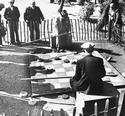 The recent history of Glasgow's once proud tradition of parks and open spaces has been one of struggle against dwindling resources and mounting vandalism particularly in less-favoured areas. The "parkie", who ruled the parks with a rod of iron, has gone, the victim of economy and changing attitudes. In some areas parks have been almost abandoned to drug dealers and junkies, but there have been some successes in the face of such adversity.
The recent history of Glasgow's once proud tradition of parks and open spaces has been one of struggle against dwindling resources and mounting vandalism particularly in less-favoured areas. The "parkie", who ruled the parks with a rod of iron, has gone, the victim of economy and changing attitudes. In some areas parks have been almost abandoned to drug dealers and junkies, but there have been some successes in the face of such adversity.
 In the 1960s and 1970s a determined stand against the tide was made under Arthur Oldham, who was Director of Parks from 1964 until 1975 and then Director of Leisure and Recreation in the Strathclyde Regional Council until he retired in 1980. In the East End, Provan Hall is a shining example of what can be achieved with its well kept gardens at the heart of the community. The restoration of the Necropolis beside the Cathedral was a triumph, allowing visitors and citizens access once again to this remarkable symbol of the prosperity and diversity of Victorian Glasgow.
In the 1960s and 1970s a determined stand against the tide was made under Arthur Oldham, who was Director of Parks from 1964 until 1975 and then Director of Leisure and Recreation in the Strathclyde Regional Council until he retired in 1980. In the East End, Provan Hall is a shining example of what can be achieved with its well kept gardens at the heart of the community. The restoration of the Necropolis beside the Cathedral was a triumph, allowing visitors and citizens access once again to this remarkable symbol of the prosperity and diversity of Victorian Glasgow.
 With growing concern at the lack of exercise taken by many Glaswegians, major investment has been made in walkways and cycleways threading the city, often making use of abandoned railway lines. The best examples are the Clyde and Kelvin riverside walkways, the towpath of the re-opened Forth & Clyde Canal and the Sustrans cycleways which link the city to Loch Lomond and the Ayrshire coast. Such thoroughfares are costly to maintain and inevitably take funds from parks and open spaces.
With growing concern at the lack of exercise taken by many Glaswegians, major investment has been made in walkways and cycleways threading the city, often making use of abandoned railway lines. The best examples are the Clyde and Kelvin riverside walkways, the towpath of the re-opened Forth & Clyde Canal and the Sustrans cycleways which link the city to Loch Lomond and the Ayrshire coast. Such thoroughfares are costly to maintain and inevitably take funds from parks and open spaces.
Everywhere there are signs of decay and decline, even in parks in fashionable areas such as the West End. Restoration is inevitably piecemeal, leaving eyesores waiting to be addressed. In 1995 Glasgow Council addressed the problem in its open spaces strategy but resources remain an issue. With easy access to cars and cheap foreign holidays the city's parks no longer fulfil the vital function of providing open space for play and recreation that they did a century ago.